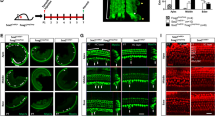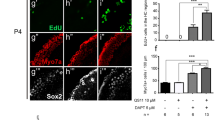Abstract
Cochlear supporting cells (SCs), which include the cochlear progenitor cells, have been shown to be a promising resource for hair cell (HC) regeneration, but the mechanisms underlying the initiation and regulation of postnatal cochlear SC proliferation are not yet fully understood. Bmi1 is a member of the Polycomb protein family and has been reported to regulate the proliferation of stem cells and progenitor cells in multiple organs. In this study, we investigated the role of Bmi1 in regulating SC and progenitor cell proliferation in neonatal mice cochleae. We first showed that knockout of Bmi1 significantly inhibited the proliferation of SCs and Lgr5-positive progenitor cells after neomycin injury in neonatal mice in vitro, and we then showed that Bmi1 deficiency significantly reduced the sphere-forming ability of the organ of Corti and Lgr5-positive progenitor cells in neonatal mice. These results suggested that Bmi1 is required for the initiation of SC and progenitor cell proliferation in neonatal mice. Next, we found that DKK1 expression was significantly upregulated, while beta-catenin and Lgr5 expression were significantly downregulated in neonatal Bmi1−/− mice compared to wild-type controls. The observation that Bmi1 knockout downregulates Wnt signaling provides compelling evidence that Bmi1 is required for the Wnt signaling pathway. Furthermore, the exogenous Wnt agonist BIO overcame the downregulation of SC proliferation in Bmi1−/− mice, suggesting that Bmi1 knockout might inhibit the proliferation of SCs via downregulation of the canonical Wnt signaling pathway. Our findings demonstrate that Bmi1 plays an important role in regulating the proliferation of cochlear SCs and Lgr5-positive progenitor cells in neonatal mice through the Wnt signaling pathway, and this suggests that Bmi1 might be a new therapeutic target for HC regeneration.







Similar content being viewed by others
References
Balak KJ, Corwin JT, Jones JE (1990) Regenerated hair cells can originate from supporting cell progeny: evidence from phototoxicity and laser ablation experiments in the lateral line system. J Neurosci 10:2502–2512
Corwin JT, Cotanche DA (1988) Regeneration of sensory hair cells after acoustic trauma. Science 240:1772–1774
Ryals BM, Rubel EW (1988) Hair cell regeneration after acoustic trauma in adult Coturnix quail. Science 240:1774–1776
Li H, Liu H, Heller S (2003) Pluripotent stem cells from the adult mouse inner ear. Nat Med 9:1293–1299
White PM, Doetzlhofer A, Lee YS, Groves AK, Segil N (2006) Mammalian cochlear supporting cells can divide and trans-differentiate into hair cells. Nature 441:984–987
Chai R, Kuo B, Wang T, Liaw EJ, Xia A, Jan TA, Liu Z, Taketo MM et al (2012) Wnt signaling induces proliferation of sensory precursors in the postnatal mouse cochlea. Proc Natl Acad Sci U S A 109:8167–8172
Chai R, Xia A, Wang T, Jan TA, Hayashi T, Bermingham-McDonogh O, Cheng AG (2011) Dynamic expression of Lgr5, a Wnt target gene, in the developing and mature mouse cochlea. J Assoc Res Otolaryngol 12:455–469
Cox BC, Chai R, Lenoir A, Liu Z, Zhang L, Nguyen D, Chalasani K, Steigelman KA et al (2014) Spontaneous hair cell regeneration in the neonatal mouse cochlea in vivo. Development 141:816–829
Jan TA, Chai R, Sayyid ZN, van Amerongen R, Xia A, Wang T, Sinkkonen ST, Zeng YA et al (2013) Tympanic border cells are Wnt-responsive and can act as progenitors for postnatal mouse cochlear cells. Development 140:1196–1206
Shi F, Hu L, Edge AS (2013) Generation of hair cells in neonatal mice by beta-catenin overexpression in Lgr5-positive cochlear progenitors. Proc Natl Acad Sci U S A 110:13851–13856
Shi F, Kempfle JS, Edge AS (2012) Wnt-responsive lgr5-expressing stem cells are hair cell progenitors in the cochlea. J Neurosci 32:9639–9648
Bohne BA, Ward PH, Fernandez C (1976) Irreversible inner ear damage from rock music. Trans Sect Otolaryngol Am Acad Ophthalmol Otolaryngol 82:ORL50–ORL59
Hawkins JE Jr, Johnsson LG, Stebbins WC, Moody DB, Coombs SL (1976) Hearing loss and cochlear pathology in monkeys after noise exposure. Acta Otolaryngol 81:337–343
Oesterle EC, Campbell S, Taylor RR, Forge A, Hume CR (2008) Sox2 and JAGGED1 expression in normal and drug-damaged adult mouse inner ear. J Assoc Res Otolaryngol 9:65–89
Bramhall NF, Shi F, Arnold K, Hochedlinger K, Edge AS (2014) Lgr5-positive supporting cells generate new hair cells in the postnatal cochlea. Stem Cell Rep 2:311–322
Li W, Wu J, Yang J, Sun S, Chai R, Chen ZY, Li H (2015) Notch inhibition induces mitotically generated hair cells in mammalian cochleae via activating the Wnt pathway. Proc Natl Acad Sci U S A 112(1):166–71. doi:10.1073/pnas.1415901112
Chen P, Segil N (1999) p27(Kip1) links cell proliferation to morphogenesis in the developing organ of Corti. Development 126:1581–1590
Kopecky B, Santi P, Johnson S, Schmitz H, Fritzsch B (2011) Conditional deletion of N-Myc disrupts neurosensory and non-sensory development of the ear. Dev Dyn 240:1373–1390
Fasano CA, Dimos JT, Ivanova NB, Lowry N, Lemischka IR, Temple S (2007) shRNA knockdown of Bmi-1 reveals a critical role for p21-Rb pathway in NSC self-renewal during development. Cell Stem Cell 1:87–99
Lessard J, Sauvageau G (2003) Bmi-1 determines the proliferative capacity of normal and leukaemic stem cells. Nature 423:255–260
Lukacs RU, Memarzadeh S, Wu H, Witte ON (2010) Bmi-1 is a crucial regulator of prostate stem cell self-renewal and malignant transformation. Cell Stem Cell 7:682–693
Park IK, Qian D, Kiel M, Becker MW, Pihalja M, Weissman IL, Morrison SJ, Clarke MF (2003) Bmi-1 is required for maintenance of adult self-renewing haematopoietic stem cells. Nature 423:302–305
Biehs B, Hu JK, Strauli NB, Sangiorgi E, Jung H, Heber RP, Ho S, Goodwin AF et al (2013) BMI1 represses Ink4a/Arf and Hox genes to regulate stem cells in the rodent incisor. Nat Cell Biol 15:846–852
Bruggeman SW, Hulsman D, Tanger E, Buckle T, Blom M, Zevenhoven J, van Tellingen O, van Lohuizen M (2007) Bmi1 controls tumor development in an Ink4a/Arf-independent manner in a mouse model for glioma. Cancer Cell 12:328–341
Jacobs JJ, Kieboom K, Marino S, DePinho RA, van Lohuizen M (1999) The oncogene and Polycomb-group gene bmi-1 regulates cell proliferation and senescence through the ink4a locus. Nature 397:164–168
Lopez-Arribillaga E, Rodilla V, Pellegrinet L, Guiu J, Iglesias M, Roman AC, Gutarra S, Gonzalez S et al (2015) Bmi1 regulates murine intestinal stem cell proliferation and self-renewal downstream of Notch. Development 142:41–50
Molofsky AV, Pardal R, Iwashita T, Park IK, Clarke MF, Morrison SJ (2003) Bmi-1 dependence distinguishes neural stem cell self-renewal from progenitor proliferation. Nature 425:962–967
Park IK, Morrison SJ, Clarke MF (2004) Bmi1, stem cells, and senescence regulation. J Clin Invest 113:175–179
Yang MH, Hsu DS, Wang HW, Wang HJ, Lan HY, Yang WH, Huang CH, Kao SY et al (2010) Bmi1 is essential in Twist1-induced epithelial-mesenchymal transition. Nat Cell Biol 12:982–992
Chen Y, Li L, Ni W, Zhang Y, Sun S, Miao D, Chai R, Li H (2015) Bmi1 regulates auditory hair cell survival by maintaining redox balance. Cell death & disease 6, e1605
Cho JH, Dimri M, Dimri GP (2013) A positive feedback loop regulates the expression of polycomb group protein BMI1 via WNT signaling pathway. J Biol Chem 288:3406–3418
Yu T, Chen X, Zhang W, Colon D, Shi J, Napier D, Rychahou P, Lu W et al (2012) Regulation of the potential marker for intestinal cells, Bmi1, by beta-catenin and the zinc finger protein KLF4: implications for colon cancer. J Biol Chem 287:3760–3768
Barker N, van Es JH, Kuipers J, Kujala P, van den Born M, Cozijnsen M, Haegebarth A, Korving J et al (2007) Identification of stem cells in small intestine and colon by marker gene Lgr5. Nature 449:1003–1007
Madisen L, Zwingman TA, Sunkin SM, Oh SW, Zariwala HA, Gu H, Ng LL, Palmiter RD et al (2010) A robust and high-throughput Cre reporting and characterization system for the whole mouse brain. Nat Neurosci 13:133–140
Acknowledgments
This work was supported by grants from the Major State Basic Research Development Program of China (973 Program) (2011CB504500, 2015CB965000), the National Natural Science Foundation of China (Nos. 81570913, 81470692, 81371094, 81230019, 81500790, 81570921, 31500852, 31501194), the Jiangsu Province Natural Science Foundation (BK20150022, BK20140620, BK20150598), the Project from China Scholarship Council (201406105052), the Program of Leading Medical Personnel in Shanghai, the Fundamental Research Funds for the Central Universities (2242014R30022, 021414380037), the Construction Program of Shanghai Committee of Science and Technology (12DZ2251700), and the Major Program of Shanghai Committee of Science and Technology (11441901000).
Author Contributions
HL and RC conceived and designed the experiments. XL, SS, QJ, ZS, WL, LL, and YZ performed the experiments. XL, SS, RC, and HL analyzed the data. DM provided the Bmi1 KO mice. XL, RC, and HL wrote the paper.
Author information
Authors and Affiliations
Corresponding authors
Ethics declarations
Conflict of Interest
The authors declare that they have no competing interests.
Additional information
Xiaoling Lu and Shan Sun contributed equally to this work.
Electronic Supplementary Material
Below is the link to the electronic supplementary material.
Supp Fig 1
Bmi1 is expressed in both HCs and SCs in the apical turn of the organ of Corti. Scale bars = 20 μm (DOCX 870 kb)
Supp Fig 2
Without damage, Lgr5 was expressed in Deiters’ cells, pillar cells, and inner phalangeal/border cells in neonatal WT mice. Scale bars = 20 μm (DOCX 717 kb)
Supp Fig 3
a Compared with P0 WT mice, the expression level of beta-catenin showed no difference in P0 Bmi1+/− mice. b The expression level of p27Kip1 in heterozygous mice showed no difference compared to P0 control. Scale bars = 20 μm (DOCX 809 kb)
Supp Fig 4
a The expression level of Lgr5 between P0 WT and Bmi1+/− mice showed no difference. b The expression level of Lgr5 between P30 WT and Bmi1+/− mice showed no difference. Scale bars = 20 μm. (DOCX 836 kb)
Rights and permissions
About this article
Cite this article
Lu, X., Sun, S., Qi, J. et al. Bmi1 Regulates the Proliferation of Cochlear Supporting Cells Via the Canonical Wnt Signaling Pathway. Mol Neurobiol 54, 1326–1339 (2017). https://doi.org/10.1007/s12035-016-9686-8
Received:
Accepted:
Published:
Issue Date:
DOI: https://doi.org/10.1007/s12035-016-9686-8




